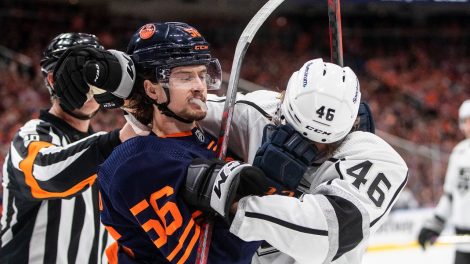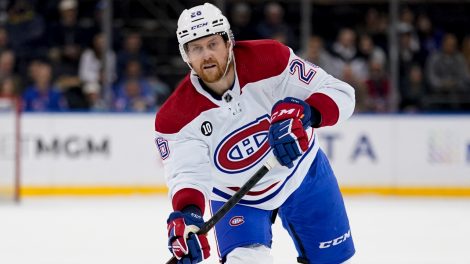It’s natural to feel like the NHL trade deadline has lost some of its shine in recent years. Even though the raw volume of trades has technically been increasing year over year since a pronounced lull in 2011, many of those trades have lacked a level of gravitas. It’s ultimately hard to get worked up about a move that almost certainly won’t have any tangible impact on either team involved.
As recently as a week ago, it looked like we were headed for more disappointment in that regard. With the loser point providing the league with the parity it craves, the gridlock in the middle of the standings didn’t separate many obvious buyers from sellers.
While things are still as tight as ever, some of the teams hanging around on the outskirts should be taking note of the early market that’s been set by the first wave of trades this week. With valuable draft picks being thrown around in bunches for spare parts, the allure of recouping value for assets that aren’t part of big picture plans could very well force certain front offices to jump into the trade market. As a result, there could be an accompanying domino effect.
Here’s a look at various prominent storylines, what recent history has taught us to look for, and how all of it fits into this year’s landscape:
WINGERS SELLING LIKE HOTCAKES
This year’s class of available rental defencemen who could potentially move the needle for contenders is awfully thin, but the same can’t be said for the crop of wingers.
To sort through the glut of options, let’s play a guessing game based on statistical resumes this season:

(all numbers are during the course of five-on-five play, pulled from War on Ice)
Player A is Andrew Ladd, who’s easily the biggest name of the bunch. Dustin Byfuglien’s long-term extension signalled the end of Ladd’s tenure in Winnipeg, with the Jets not-so-quietly auctioning him off to the highest bidder for weeks. Ladd’s reputation around the league, his specific set of traits that theoretically translate well to playoff hockey, and an extremely palatable $4.5 million cap hit meant that Winnipeg surely wasn’t short on suitors.
In a move where the rich got richer, the Blackhawks acquired his services, filling a need on Jonathan Toews’ wing. The price they paid to get him was certainly a generous one, but ultimately won’t matter if they win their fourth Stanley Cup in seven years. Maybe the more interesting takeaway from the trade was what it means for the other names left on the block, and whether the premium price that was paid permeates into any of the deals to come.
Player B is Mikkel Boedker, a name that’s been gaining more traction as a trade candidate amidst reports that the Coyotes pulled their contract offer to him off the table. I can’t say that I blame them. There’s a noticeable divide between the career high stats he’s trending towards and what the underlying data suggests about his play. Being used as a top line option and fed a healthy dose of minutes has largely factored into those ballooned box score numbers. It’s worth noting that no forward, not even Alex Ovechkin, has received more minutes with the man advantage than Boedker this season. It’s funny how that works.
Player C is Lee Stempniak, who could be on his way to playing for the ninth different team in his career. It’s a shame, really, because by the time his playing days are done Stempniak will be known more for his pivotal role as deadline day fodder than the incredibly versatile player he’s been at each stop.
The fact he’s leading a team that it’s in the middle of a playoff race in scoring, just a few months after being invited to their training camp on a tryout, hasn’t been receiving nearly the attention it deserves, which is perfectly fitting. Some of the production listed above is being propped up by a favourable percentage spike, but considering what other players with similar resumes will get traded for, a savvy team would do well to quietly steal Stempniak from the Devils for a bag of sticks and pucks.
With other names such as Loui Eriksson, Teddy Purcell, Jiri Hudler, Radim Vrbata, and P.A. Parenteau all available, there will be plenty of options to choose from for teams looking to upgrade a middle-six wing spot at the deadline.
THE CANUCKS NEED TO MOVE ASSETS
Based on Jim Benning’s first 20-plus months behind the wheel in Vancouver, it sure looks like he is the GM his peers should be going out of their way to feast on while they still can.
The Canucks are a franchise in shambles, seemingly without a consistent, coherent thought process to guide most of their moves. They’re an aging team with a collection of depreciating assets they either can’t, or won’t, move. The sad reality is that in a tone deaf attempt to appease an increasingly restless fan base and an uneasy ownership group, they’ve stumbled into the worst possible position for a pro sports organization.
Their best players are good enough to keep them afloat on occasion, but the large majority of the supporting group is bad enough to submarine the collective effort.
While there’s been a recent outcry against certain teams for “tanking” it’s a completely defensible strategy for as long as the system rewards it. A much worse fate would be to get stuck in mediocrity.
That’s where the Canucks are at right now. Despite being 24th in shot attempts and 29th in scoring chances this season, the combination of the Sedins’ continued greatness and a surprisingly respectable performance by Ryan Miller has disillusioned them into believing they’re actually in the hunt for a playoff spot.
Trading the likes of Dan Hamhuis and Radim Vrbata in the next couple of days would be a good first step towards accumulating draft picks and prospects like they should’ve been doing all along.
THE DO NOT TRADE FOR LIST
There’s a time-tested tradition that comes up on an annual basis around the deadline. Good teams convince themselves the biggest need they have to address is improving their depth on the blueline.
In theory, it’s understandable. It feels like there’s generally a league-wide shortage of legitimately useful defencemen. It’s a difficult position to play, but it’s an even more difficult position to properly evaluate. Unlike with forwards where we can use more rudimentary metrics to quantify their performance, properly attributing certain contributions statistically is more nuanced for defencemen.
In light of that, most teams wind up falling into the trap of rounding out their blueline with prototypically conservative players – rugged guys who play with an edge. The issue is that in most cases those particular qualities aren’t all that important, which makes them liabilities on the ice when given enough exposure.
Come the trade deadline, those same GMs responsible for making that initial decision, size up their team and correctly surmise that those sixth and seventh spots on their bluelines are the most glaring hole. Then in an ironically roundabout way, they attempt to atone for those shortfalls by acquiring different players who have the very same flaws.
We just saw that happen in Washington, where the Capitals gave up a third round pick to essentially stabilize their blueline depth with a worse version of Brooks Orpik. Mike Weber, whose underlying numbers unsurprisingly skyrocketed thanks to being strapped to Cody Franson’s hip, has been one of the worst regularly used players in the league for years. He takes a ton of penalties, he spends most of his time on the ice chasing the puck in his own zone, and in turn he provides essentially no value on the other end of the ice.
In the grand scheme of things it’s a relatively small quibble given the dominant team the Capitals have assembled, but it’s nonetheless the latest example of a mystifying larger trend in the league.
One of the reasons it keeps happening is good defencemen who can actually make a difference probably won’t be made available. With players such as Kevin Shattenkirk, Keith Yandle, and Brian Campbell being taken off the market, the pickings are incredibly slim.
Beyond Hamhuis, Radko Gudas – who was actually quite good for the Flyers this year prior to Michael Del Zotto’s injury – looks like the next best option. Yet the reported asking price of two second round picks, matching the haul the Leafs got for a similar player in Roman Polak, seems awfully steep for a limited player who’s a ticking suspension time bomb.
The other two names that have been surfacing frequently are Kris Russell and Justin Schultz, both of whom don’t provide much beyond the snake oil they’ll both be trying to sell to teams this summer.
One particular team Russell has been linked to are the Penguins, which seem like an odd fit. Russell’s shot blocking totals are impressive, assuming you’re overlooking the fact the reason for it is solely because his team never has the puck when he’s on the ice. While that sort of style may’ve been a fit in Pittsburgh earlier in the year, ever since Mike Sullivan took over behind the bench they’ve been a completely different team:
The addition of Russell would fly completely in the face of everything the Penguins have craftily done to turn their season around since the coaching change. While Sidney Crosby’s resurgence has received most of the attention, the way Jim Rutherford and Sullivan have rebuilt the blueline on the fly is a big reason why. With Kris Letang and Olli Maatta getting healthy, Derrick Pouliot being called up from the minors, and Trevor Daley replacing Rob Scuderi, the Penguins have assembled a group of players who can effectively transition the puck from their own end towards the neutral zone, allowing the immense skill of Crosby, Malkin, and Kessel to do the rest. The fit between that and Russell’s game seems like a rather odd one.
As for Schultz, he’ll surely get another couple of cracks at turning his career around. Former highly regard prospects get an immensely long leash in this league to try and rekindle whatever magic made them successful at earlier stages in their development.
The issue for Schultz is he hasn’t shown a single shred of evidence that he actually understands how to play the position. While you can’t teach the types of physical tools he was blessed with, if a 26-year-old who’s been in the league for four years hasn’t displayed a fundamental understanding of where he needs to be when he’s on the ice, he likely never will.










